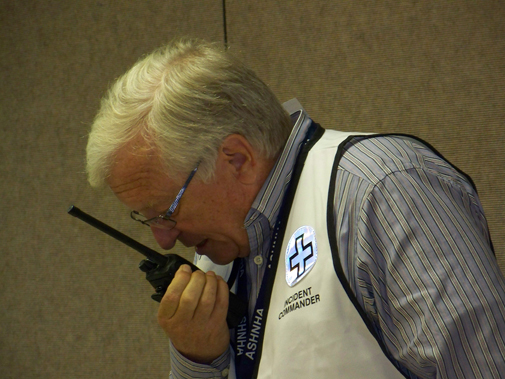At 9:36 a.m. Tuesday, handheld radios buzzed to life at South Peninsula Hospital as Bob Letson, the hospital’s chief executive officer, announced the beginning of a drill to test the facility’s evacuation procedures.
Under the watchful eye of Bob Becker, a certified healthcare emergency professional with Incident Management Solutions of New York, hospital departments listened for Letson’s orders, gave updates on the condition and location of patients being role-played by community volunteers, and dealt with unexpected challenges.
“The number one failure is communications,” said Becker of the straw that can break the back of any emergency response.
No sooner had he said that than Letson’s radio began experiencing problems. That and other radio malfunctions were overcome by runners who delivered messages in order to keep the drill going and procedures followed.
A long-term care “patient,” who was not ambulatory, had to be moved in her bed from the second floor to a staging location outdoors, providing an opportunity for staff to use a walkway constructed along the back of the hospital specifically for such an occasion.
Throwing a curve ball into the scenario, Becker, whose company works with more than 140 institutions in the United States and abroad to develop emergency preparedness plans, inserted himself into the drill as an unescorted news reporter, interrupting responders, asking for information, questioning their ability to handle the situation. Without exception, hospital staff followed procedures, directing Becker to Derotha Ferraro, the event’s public information officer.
At 10:32 a.m., with all “patients” evacuated and accounted for, Letson announced the drill had come to an end.
Thanking the volunteers for their participation, Becker said he hoped the exercise offered opportunities for them to know more about the hospital, as well as “respect for the people that work here.”
Later in the day, a “hot wash” was scheduled with Becker and the hospital’s incident command team, a meeting to review the drill. Within the next 10 days a 19-page “after-action” report will be completed outlining the hospital’s performance, identifying weaknesses and making recommendations for improvement.
“So the exercise is not complete until the deficiencies have been addressed in writing and we move onto the next exercise,” said Becker.
Incident Management Solutions has been working with South Peninsula Hospital for four years to develop its comprehensive emergency management plan.
“We have conducted various training programs for the hospital,“ said Becker. In addition, IMS has made recommendations for the purchase of equipment for both clinical and nonclinical operations.
Events such as this are funded through a state grant, according to Ferraro.
“Two years ago we didn’t even have an evacuation plan,” she said. “Now we have written documents to lead the exercise.”
The hospital’s connection with Becker was made at a hospital preparedness conference in Anchorage.
“His entire life has been hospital facilities and emergency preparedness,” said Ferraro. “He has tremendous hands-on experience, is a really great leader and personality.”
At previous visits to SPH, Becker conducted tabletop drills for different levels of the incident command system, but Tuesday was the first actual exercise.
“The hospital has done exceedingly well on part surveys,” said Becker. “They’ve been extremely enthusiastic about this exercise. There’s a total commitment here at South Peninsula Hospital to reach the highest levels of perform ace and readiness. It’s demonstrated on every trip that I’ve made out here.”
McKibben Jackinsky can be reached at mckibben.jackinsky@homernews.com.


